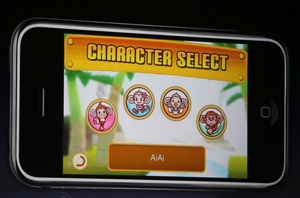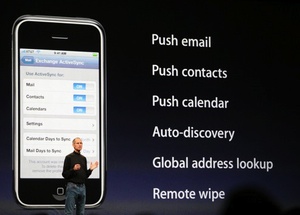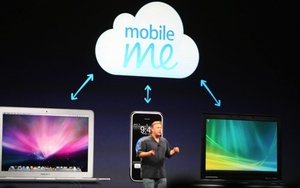Apple introduced iPhone 2.0 today at the World Wide Developers Conference.
Yes, it supports 3G and faster data networks.
Yes, it supports GPS.
Yes, it has a few cosmetic changes and is thinner.
Yes, it carries a (dramatically) lower price: $199 for the 8 GB iPhone, $299 for the 16 GB model.
No, it’s not immediately available, but you can get it in 22 countries starting July 11.
As far as some of the other rumors floating around . . .
Microsoft Exchange and full enterprise support is enabled out of the box.
“Exchange for the rest of us” will be available through MobileMe and Me.com, the re-branding of .Mac.
Third-party applications and the App Store will be available in early July.
No, there does not appear to be an improved camera or video recording (including video chat) of any kind. There’s no Flash support. Or external storage slots. And still no cut and paste! What gives?
Anyway, a tour through today’s keynote.
From the start
As previously stated, the WWDC sold out — more than 5,200 people attended. Even Al Gore!
The new Mac OS, Snow Leopard, was mentioned at the start but received no other word. Guess there will be more on that later. The remainder of the Keynote was all iPhone.
After Apple introduced the software developers kit in March, 25,000 people applied for the beta development program, 4,000 were accepted.
The enterprise will be supported out of the box, including push email, contacts, calendar, auto-discovery, a global address book, and remote wipe when a phone is lost or stolen.
An interesting tidbit: 35 percent of Fortune 500 companies participated in the enterprise development, although no word if they did this on their own because they wanted to support the effort or whether Apple asked them.
SDK and third-party apps
This took up a bulk of the keynote, and most of the live bloggers found the demonstrations boring. We disagree. There are some interesting applications, although developers still have not shown all of what can be done.
Nearby Friends: Apple demo’d an app that shows your contacts within a 10-mile radius; it uses the Address Book API and Core Location API.
 SuperMonkeyBall: Ethan Einhorn from Sega showed a more mature game — 110 stages of the game are complete — and how well the tilt-control works. SuperMonekyBall will be available at the launch of the App Store in early July for $9.99.
SuperMonkeyBall: Ethan Einhorn from Sega showed a more mature game — 110 stages of the game are complete — and how well the tilt-control works. SuperMonekyBall will be available at the launch of the App Store in early July for $9.99.
eBay: The online auction site demonstrated Auctions on the iPhone, which incorporates much of the eBay functionality including a quick view of the auctions you’ve listed, have bid on, or have lost. It will be free.
Loopt: Another location-based social network, Loopt displays you and your friends via pins on a map. “We make serendipity happen,” Sam Altman of Loopt said. Interestingly, you will be able to use it with your friends on other carriers and other mobile OS. Free.
TypePad: The popular blogging service has developed a native app that will make it simple to blog or photoblog. Free.
Associated Press: The AP’s Mobile News Network will gather content from many sources. It uses the location API to show nearby sources. News video and photos can be viewed in the app, which is a nice touch. What’s unexpected: You can report the news yourself by sending a first-hand report that includes text and photos. Free.
Enigmo and Cro-Mag Rally: Games developed by Pangea Software. Enigmo is physics-based game using touch controls and the the phone’s CPU; Rally is a 3D racing game, using the iPhone as the steering wheel. $9.99 each.
Band from Moo Cow Music: a collection of virtual instruments (piano, drums, 12-bar blues “guitar”, bass) for creating music from scratch.
 MLB.com: Shows today’s games with live, detailed scoring; also includes real-time video highlights delivered at the conclusion of the play, not the game. It’s an app I could have used yesterday even when attending the ball game.
MLB.com: Shows today’s games with live, detailed scoring; also includes real-time video highlights delivered at the conclusion of the play, not the game. It’s an app I could have used yesterday even when attending the ball game.
Modality: It showed a slick learning app to help students remember the names of parts of the body.
MIMvista: It showed another app for viewing medical imagery; it takes advantage of the touch screen to change the information shown, zooming in and out, and rendered images can be 3D.
Digital Legends: Showed a 3D fantasy game using OpenGL and touch controls. It will be ready by September and available over Wi-Fi and the 3G cell network.
New Features
While this was not specifically called for by average users, Apple has been working on ways to allow for “background support.” Always-on application support is bad for battery life and performance. Apple’s solution is push notification, allowing users to run applications like instant messaging in the background.
When a user quits an application, Apple will push updates from their servers to the iPhone. The developer’s servers push the notifications to Apple. Updates can include badges, sounds, custom messages. This functionality will be available in September.
Other features include:
- Contact search with live searching
- Full iWork document support
- Complete support for Office documents Word, Excel, and PowerPoint
- Bulk delete and move for messages
- Save images you receive
- Calculator with scientific mode when you rotate iPhone
- Parental controls
- Language support
The iPhone 2.0 software upgrade will be available in early July, free for iPhone owners, $9.99 for iPod Touch owners.
App Store
Not many details were forthcoming.
As previously noted, developers will keep 70 percent of revenue; there will be no charge for free apps (like taxes or transfer fees). The store will be available in 62 countries.
If apps are less than 10 MB, they can be downloaded through the 3G cell network, otherwise Wi-Fi or iTunes is needed.
An enterprise note: Businesses can authorize iPhones within their enterprise and create applications just to run on those phones; these apps can be distributed via their intranets.
Another form of distribution is Ad Hoc. Apps can be distributed in an ad hoc, as needed, fashion for up to 100 authorized phones.
The re-branding of .Mac was introduced, aptly, as “Exchange for the rest of us.”
With MobileMe, a $99 annual subscription, non-Exchanging using iPhone owners can get push email, contacts, and calendars wherever we are.
MobileMe works over the air to keep Mail, iCal, Address Book on the Mac and Outlook for Windows in sync bi-directionally between the iPhone, Mac, and PC. Photos are also synced over-the-air.
The Web component to MobileMe, the old .Mac, is now called Me.com. Type in your account information into Me.com and get a new desktop-like experience to interact with and manage mail, calendar, and contacts.
Me.com includes 20 GB of storage space — iDisk is integrated for easier file transfers and sharing. Current .Mac subscribers will be automatically updated. A 60-day trial will be available with the iPhone 2.0 software in early July.
No word on improved speed, though.
The iPhone
 In its first year, 6 million iPhones were sold until Apple ran out of them a few weeks ago. Apple, of course, reported very favorable numbers: 90 percent customer satisfaction, 98 percent of users browsed online, 94 percent sent email, 90 percent sent text messages, 80 percent reported using 10 or more features.
In its first year, 6 million iPhones were sold until Apple ran out of them a few weeks ago. Apple, of course, reported very favorable numbers: 90 percent customer satisfaction, 98 percent of users browsed online, 94 percent sent email, 90 percent sent text messages, 80 percent reported using 10 or more features.
As Apple CEO Steve Jobs noted, Apple faced five significant challenges with the new iPhone.
- 3g network support (see below)
- enterprise support (done)
- third party apps (done)
- available in more countries (mostly complete, 70 total countries)
- more affordable (see below)
3G: The new iPhone will be thinner, with a black plastic back, solid metal buttons, the same display and camera, and a flush headphone jack and improved audio.
To show off the speed improvements, Apple demonstrated the 3G phone vs. 2G. Rest assured, it’s faster, almost as fast as a Wi-Fi network. One example: It took 21 seconds to download a page on a 3G phone, 59 seconds on the EDGE network.
Apple says the 3G iPhone will sport much improved battery life: 300 hours standby, 5 hours talk time, 5 to 6 hours of high speed browsing, 7 hours of video, and 24 hours of audio. That seems awfully best-case-scenario to us.
GPS: The new iPhone will support GPS as well as location through cell towers and Wi-Fi networks. Expect a boatload of location-based and presence services and applications coming soon to an iPhone near you.
Price: iPhone 1.0 started at $599. The 3G 8 GB model will sell for $199, $299 for 16 GB. A white version also be available.
Photo credits: Engadget




I have not much time, but I've got many useful things here, love it!